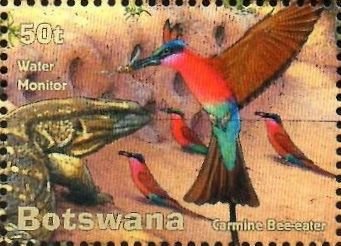Stamp: Water Monitor and Carmine Bee-eater (Merops nubicus) (Botswana 2001)
Water Monitor and Carmine Bee-eater (Merops nubicus) (Botswana 2001)
12 December (Botswana ) within release National Parks goes into circulation Stamp Water Monitor and Carmine Bee-eater (Merops nubicus) face value 50 Botswana thebe
| Stamp Water Monitor and Carmine Bee-eater (Merops nubicus) in catalogues | |
|---|---|
| Michel: | Mi: BW 731 |
| Stamp Number: | Sn: BW 726 |
Stamp is horizontal format.
Also in the issue National Parks:
- Stamp - African Elephant (Loxodonta africana) face value 3;
- Souvenir Sheet - African Fauna face value 9.75;
- Stamp - Buffalo (Syncerus caffer) face value 1.75;
- Stamp - Water Monitor and Carmine Bee-eater (Merops nubicus) face value 50;
- Stamp - Savanna Baboon (Papio cynocephalus) face value 2;
- Stamp - Lion (Panthera leo) face value 2.50;
Stamp Water Monitor and Carmine Bee-eater (Merops nubicus) it reflects the thematic directions:
Animals are multicellular, eukaryotic organisms of the kingdom Animalia (also called Metazoa). All animals are motile, meaning they can move spontaneously and independently, at some point in their lives. Their body plan eventually becomes fixed as they develop, although some undergo a process of metamorphosis later on in their lives. All animals are heterotrophs: they must ingest other organisms or their products for sustenance.
Birds (Aves), a subgroup of Reptiles, are the last living examples of Dinosaurs. They are a group of endothermic vertebrates, characterised by feathers, toothless beaked jaws, the laying of hard-shelled eggs, a high metabolic rate, a four-chambered heart, and a strong yet lightweight skeleton. Birds live worldwide and range in size from the 5 cm (2 in) bee hummingbird to the 2.75 m (9 ft) ostrich. They rank as the class of tetrapods with the most living species, at approximately ten thousand, with more than half of these being passerines, sometimes known as perching birds. Birds are the closest living relatives of crocodilians.
Reptiles are tetrapod (four-limbed vertebrate) animals in the class Reptilia, comprising today's turtles, crocodilians, snakes, amphisbaenians, lizards, tuatara, and their extinct relatives. The study of these traditional reptile orders, historically combined with that of modern amphibians, is called herpetology. Because some reptiles are more closely related to birds than they are to other reptiles (e.g., crocodiles are more closely related to birds than they are to lizards), the traditional groups of "reptiles" listed above do not together constitute a monophyletic grouping (or clade). For this reason, many modern scientists prefer to consider the birds part of Reptilia as well, thereby making Reptilia a monophyletic class.



